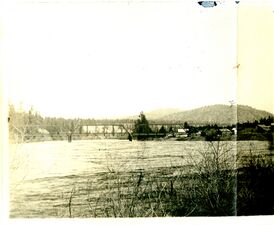Lapray Bridge
DRAFT--This page is a draft. It is incomplete, not proof read and may contain research notes
The Colville Road was established in 1860 to move goods from Walla Walla to Fort Colville. The road crossed the Spokane River at a spot called the Winding Ford. This was about 3 miles upstream of the site of Long Lake Dam. Fording the river really only works in very low water situations, so James Monaghan established a ferry service there. In 1865, he and William Nix got Territorial approval to built a toll bridge.
He was one of the earliest white residents of area and lived peacefully among the Indians. His nearest neighbors were a hundred miles away in the Palouse. In 1882 he sold the bridge to Joseph Lapray also establishes a saw mill "somewhere in Lincoln county" which will produce lumber for the bridge. This bridge becomes known hearafter as the Lapray Bridge.
From findagrave.com:
"Joseph Lapray was born in Montreal, Canada, Jan 3, 1834. At the age of 14 he graduated from Catholic College of Montreal and struck out on his own coming to the United States. Finding a friend in Charles H Montgomery they came to Colville together in 1859. It was to be only a temporary stop, since both were interested in mining on the Frazier River Valley in Canada. It was not to be. Lapray first bought property near Colville, but in 1874 moved to Walker's Prairie west of the present town of Springdale. There he homesteaded 160 acres and then added to that until he owned over a thousand acres. He engaged in the cattle business, having a herd of over 600 head. In 1882 Lapray had a sawmill in Lincoln County He was a friend of James Monaghan, who had built a bridge across the Spokane River, Lapray purchased the bridge and with lumber from his sawmill rebuilt the bridge. He then collected toll for persons using it. The bridge became famous as the Lapray bridge, which was the only crossing point of the Spokane River on the old military road between Walla Walla and Fort Colville. Lapray later sold the bridge to Stevens County. It was used for many years, until a dam built on the Spokane River backed up water that necessitated the demise of the bridge. Meanwhile, Lapray distinguished himself with his business ability, public spirit and force of character. He was a member of the Republican party and served one term as treasurer of Stevens County. He was an active member of the Catholic church. He passed away in 1900. In 1872 Lapray married Roseline Miganault, a native of France. To this union were born six children: Alice, Edward, Joseph, George, Corinne and Florence." (The People... Who Will Live in Colville Area History... 1989 Centennial celebration book. page 97)
In 1894 the commissioners of Spokane and Stevens County decided that a free bridge was more suitable to its citizens. When the Spokane county commissioners had approved the construction, they found that the Stevens county had rejected the proposal. Opposition to the bridge was a group of merchants who wanted to keep the trade locally and not have their neighbors easily accessing Spokane and their merchants. Eventually the bridge was built a short distance upstream of the ferry. In 1908, the bridge had to be replaced.
The construction of Long Lake dam again threatened the Lapray bridge, but this time it was to be more permanent. The bridge would be about 40 feet under water when Long Lake was filled. Washington Water Power Company purchased the bridge from Spokane and Stevens counties and built a new road and bridge to cross the river below the dam. The new bridge was between Lincoln and Stevens counties. This bridge used the structure of the railroad bridge built to supply building materials to the dam from Springdale.
Two of the three spans were salvaged. These went into a down river bridge near Fort George Wright.
DRAFT--This page is a draft. It is incomplete, not proof read and may contain research notes




